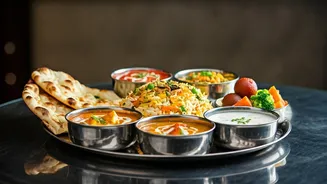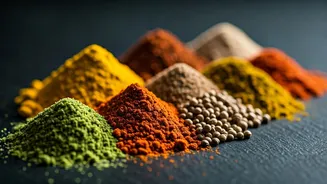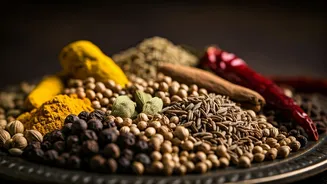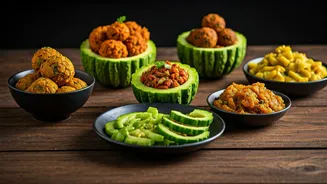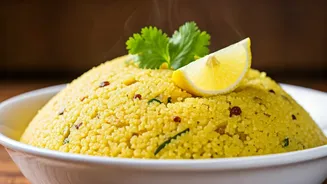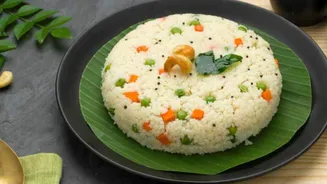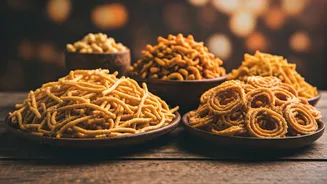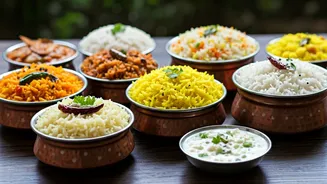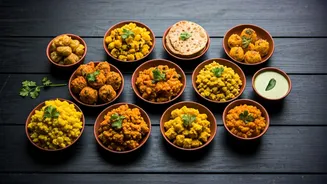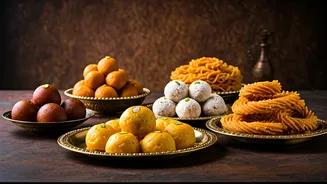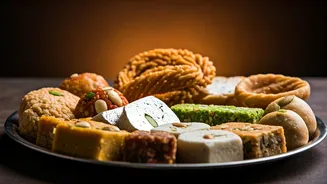Chole's Hearty Essence
Chole, a beloved chickpea curry, is a staple across India, celebrated for its rich flavors and comforting warmth. Its preparation varies regionally, yet
the essence remains the same: chickpeas simmered in a medley of aromatic spices, creating a dish that's both hearty and flavorful. The foundation of a great chole begins with perfectly cooked chickpeas, softened to the ideal texture. The spice blend is crucial, with ingredients like cumin, coriander, turmeric, and garam masala coming together to create a complex taste profile. The addition of tomatoes provides a tangy counterpoint, while onions and garlic contribute depth. Some versions include a hint of sourness, often from dried mango powder (amchur), or the addition of tea bags for color and further depth. Chole is often enjoyed with bhatura or rice, making it a complete meal that offers satisfaction in every bite. Consider experimenting with different spice ratios to discover your preferred version of this iconic dish.
Paneer's Versatile Appeal
Paneer, a fresh Indian cheese, reigns supreme in vegetarian cuisine, offering a versatile base for countless dishes. Its mild, milky flavor makes it a perfect canvas for absorbing the flavors of various spices and sauces. Paneer can be used in numerous ways – from cubes simmered in creamy gravies to grilled pieces added to vegetable wraps. Paneer Butter Masala, a rich, creamy preparation, is a popular choice, showcasing paneer's ability to shine in a luxurious dish. Palak Paneer is another favored option, featuring paneer submerged in a spinach puree, delivering a balance of health and flavor. The key to excellent paneer dishes is to use fresh, high-quality paneer and to cook it carefully, so it retains its soft texture and doesn't become rubbery. For best results, avoid overcooking paneer. Experiment with different cooking techniques, such as pan-frying, grilling, or adding it raw to salads, and discover the multitude of ways to make the most of this adaptable ingredient.
Rasgulla and Rasmalai
India's dessert scene is rich, featuring delightful sweets such as Rasgulla and Rasmalai. Rasgulla, soft cheese balls immersed in light sugar syrup, is known for its spongy texture and subtle sweetness. The preparation involves boiling the cheese balls in syrup until they expand and soak up the sweetness. Freshly made rasgullas are a treat, offering a melt-in-your-mouth experience. Rasmalai, on the other hand, presents paneer patties steeped in creamy, sweetened milk. The milk is often flavored with cardamom and saffron, providing a fragrant and luxurious taste. This dessert marries the creamy texture of the milk with the soft paneer, creating a pleasing combination of tastes. Both Rasgulla and Rasmalai have significant cultural importance, commonly enjoyed during festive celebrations and special events. These sweets are testament to the Indian skill of creating delicate and flavorful desserts.
Samosa's Fried Delight
Samosa, a deep-fried pastry filled with spiced potatoes, peas, and often other vegetables, is a beloved snack across India. The crispy, golden exterior encases a savory filling, creating a contrast of textures that makes samosas irresistible. The filling is usually spiced with ingredients such as ginger, chilies, and garam masala, giving it a rich flavor. Samosas are often served with mint chutney or tamarind chutney, which enhance the flavor, offering a balance of heat, sweetness, and tanginess. Different regions offer variations, with slight changes in the spice blends and fillings. Samosas are not just a snack; they embody the spirit of Indian street food and are a favorite for casual gatherings and festive events alike. The act of biting into a perfectly made samosa, with its crunchy exterior and flavorsome inside, is a quintessential Indian experience.
Rajma and Dal Makhani
Rajma, kidney bean curry, and Dal Makhani, black lentil curry, are two of the most loved comfort foods in India. Rajma, with its creamy texture and rich, tomato-based gravy, often features a variety of spices that create a warm, inviting flavor profile. Commonly served with rice, rajma makes for a satisfying meal, especially during colder months. Dal Makhani, on the other hand, showcases black lentils and kidney beans simmered overnight in a creamy tomato sauce and a generous amount of butter. This slow-cooking process provides a deep, luxurious flavor that is both rich and complex. Dal Makhani is usually finished with fresh cream and more butter, enhancing its creamy texture. Both Rajma and Dal Makhani are celebrated across the country, often a highlight of any celebratory feast or family gathering. These curries exemplify the way Indian cooking transforms simple ingredients into meals filled with taste.
Kaju Katli and Jalebi
Kaju Katli and Jalebi represent the sweet side of Indian cuisine, each offering unique textures and tastes that cater to different preferences. Kaju Katli, or cashew fudge, is a festive sweet made from cashew paste, sugar, and sometimes cardamom, molded into diamond shapes. Its delicate, melt-in-your-mouth texture is offset by a mild sweetness, making it a favorite for celebrations and gifting. Jalebi, on the other hand, presents a crispy exterior that is dipped in sugar syrup, resulting in a sweet and syrupy treat. The batter is deep-fried in pretzel-like spirals. It's often eaten warm, making the crunchy outside and sweet inside a joyful experience. Both Kaju Katli and Jalebi demonstrate the breadth of India’s culinary heritage, showcasing a variety of techniques and ingredients that create a memorable experience.
Evening Snack Options
Evening snacks in India offer a variety of options, providing tasty treats to enjoy. Upma, made from semolina, is a quick and light choice, seasoned with spices and vegetables to enhance its flavor. Rava Ladoo, a sweet treat made from semolina, is another option, with a soft interior and rich taste, often prepared with ghee and dried fruits to enrich its flavor profile. Other choices for snacks include savory snacks like samosas and other fried options. These snacks often come with tea or coffee, creating moments of relaxation after the day. They represent the diversity of Indian culinary traditions, catering to different tastes and cravings. Enjoying these snacks with friends or family is a common practice, highlighting the social aspect of food.
Dinner Delights & Rice
Indian dinner menus frequently include a variety of dishes, catering to different tastes and preferences. Paneer Butter Masala, with its rich and creamy tomato sauce and soft paneer, stands as a popular choice. Malai Kofta, featuring vegetable balls in a creamy gravy, offers another option that can be enjoyed with rice or roti. Rice dishes are fundamental to Indian dinner fare. Rice serves as a versatile staple, and can be prepared in various forms, from simple steamed rice to flavored options such as biryani or pulao. The type of rice is often chosen based on the region and specific dishes. A balanced Indian dinner usually includes a variety of textures and flavors. It aims to offer satisfaction through a combination of savory curries, flavorful rice or bread, providing a wholesome and memorable dining experience.
Sweet Endings: Kheer
Kheer, a rice pudding, is a cherished dessert across India. This creamy treat is made by slowly simmering rice in milk, with sugar, and often flavored with cardamom, saffron, and nuts. Kheer is known for its smooth texture and subtle sweetness. Recipes vary regionally, with some versions including ingredients like condensed milk or different types of rice. It's often served warm or chilled. Kheer is a common dish for festive occasions and celebrations, reflecting the importance of desserts in Indian culinary tradition. Its comforting nature and simple elegance make it a beloved dish.
